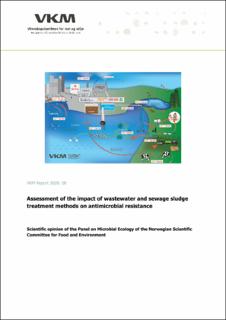| dc.description.abstract | The request from NFSA and NEA: Antimicrobial agents and microorganisms are introduced to sewage systems by different human activities, from private homes, institutions such as schools and hospitals, office buildings, industrial and commercial activities, i.e., from everywhere where people work and live. The Norwegian Food Safety Authority (NFSA) and Norwegian Environment Agency (NEA) asked the Norwegian Scientific Committee for Food and Environment (Vitenskapskomiteen for mat og miljø, VKM) for an extension of the 2009 VKM report “Risk assessment of contaminants in sewage sludge applied on Norwegian soils” regarding the impact of wastewater (WW)- and sewage sludge treatment methods used in Norway, on the fate and survival of antimicrobial resistant bacteria, fate of antimicrobial resistance genes, and main drivers for resistance (e.g. antibiotics, antifungal agents, heavy metals, disinfectants). The request addressed by VKM: VKM appointed a working group, consisting of three members of the Panel on Microbial Ecology, four external members and VKM staff to prepare a draft Opinion document. The Panel on Microbial Ecology has reviewed and revised the draft prepared by the working group and approved the Opinion document “Assessment of the impact of wastewater and sewage sludge treatment methods on antimicrobial resistance”. The antimicrobial resistance cycle: Exposure to antimicrobial agents is regarded as the most important driver for development and dissemination of AMR in microorganisms. Consequently, an important location for the development of AMR is the gut of humans or animals receiving antimicrobial drug therapy. As ARB, ARG, resistance genes and antimicrobial agents will end up in the WW system, this system could be regarded as a potential hot spot for interactions between different microorganisms, between different antimicrobial agents, and between microorganisms and antimicrobial agents. Hospitals and pharmaceutical companies are regarded as being an important source for antimicrobial drug residues released in WW. At the wastewater treatment plant (WWTP), bacteria and genes end up either in the effluent wastewater fraction or in the sludge fraction. When ARB and ARG are distributed with the WW sludge, they may reach arable land when the sludge is used as soil improver and fertilising product, and thus be recycled into the food-production chain. When following the effluent WW fraction, ARB and ARB will be released into WW recipients, such as lakes, rivers or fjords, and may, from these environments, also be recycled into food production. In each step of these cycles, ARB and ARG will be introduced into new environmental compartments to which they must adapt, and to microbial communities with which they must compete for survival and growth. Depending on the bacterial species, these new environmental compartments will be more or less hostile, but they will also provide opportunities for microbial interactions, like dissemination of ARG due to horizontal gene transfer (HGT) within and between bacterial species. Findings: It is challenging to deliver a general assessment of the nature of as well as the probability for direct discharge of ARB and ARG into effluent WW and applied sludge. This is due to the combined complexity of resistance carriers, traits, various sources of variation, and the WW systems. Moreover, there is currently a lack of harmonized methods and protocols to compare studies from different systems. However, there are no strong indications that there is a significant enrichment of ARB in WWTP operated under European conditions, which, on a general level, also applies to the Norwegian situation. Although some studies indicate a slight increase in the fraction of ARB, the absolute reduction in bacterial load during WW treatment (WWT) is significant; removal of between 99 % to 99.9 % of faecal indicator bacteria is generally achieved by secondary ....... | en_US |
